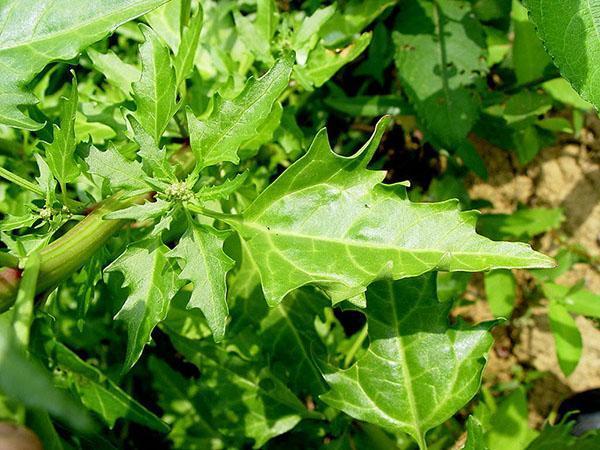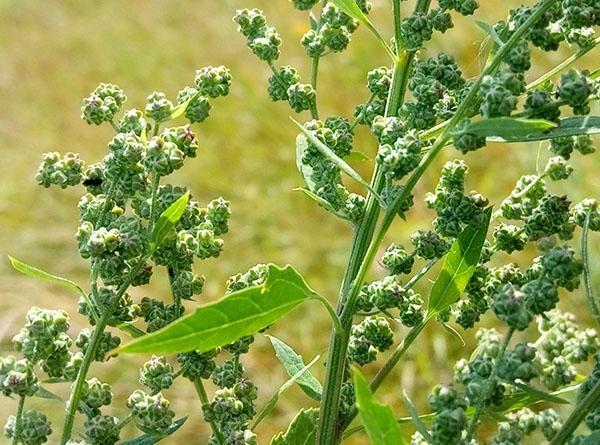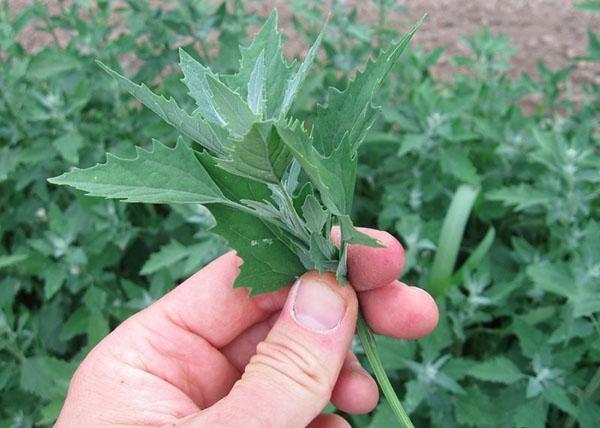Useful properties of quinoa or when a weed becomes a "companion"

There is one simple pattern in life: often difficulties open up new opportunities for a person. So, having learned the beneficial properties of quinoa, many gardeners begin to treat her not as an annoying weed, but as miraculous medicine. Moreover, from the dried leaves of the herb, a powder is made, which serves as an excellent fertilizer. It is used to saturate the earth nitrogen compounds. Quinoa also draws out all heavy salts from the soil, so the most cleansing it from harmful pollution. So you don't need to panic if she appeared in the garden. Its seeds and foliage can be safely used for treating your family.

Quinoa belongs to the Amaranth family, which are nitrophytes. In turn, they prefer to grow in nitrogen-rich soils. That is why these noxious weeds are "frequent guests" of cultivated land.
Chemical the composition of the quinoa: what experts say

As part of an unpretentious plant, 17 amino acids were found that are so necessary for our body. Quinoa cannot synthesize them on its own, so it takes these organic compounds from food. In addition, the herb contains a high percentage of protein compounds (30%) - protein. Scientists claim that due to this, it can become a "competitor" to some types of meat.
Among other things, the chemical composition of quinoa also includes:
- carbohydrates (2.27 g);
- alkaloids;
- fats (0.16 g);
- fiber (40%);
- vitamins of group B, as well as vitamins C, A, PP and E;
- acids (nicotinic, oxalic);
- essential oils (saponin).
Most of all in weed grass contains potassium (1070 mg) and calcium (349 mg). It also contains up to 164 mg of magnesium, 56 mg of phosphorus and 4 mg of sodium. It is worth adding to this collection such trace elements as manganese and iron (up to 1.5 mg), as well as copper and zinc (less than 1 mg).

On the territory of Russia, 6 varieties of weeds are most popular. The most common variety is the spreading quinoa. At the same time, it is recommended to take only garden food for food. Delicious salads are made from it.
You need to know that the plant contains up to 194 mg of vitamin A. This is what determines the beneficial properties of quinoa. This is an organic compound affects the full development of the whole organism, but especially reproductive organs, eyes and skin. It also stabilizes the immune systems. Meanwhile, vitamin B2 (0.27 mg) is actively involved in OVR (redox reactions). Through such processes, cells saturated with oxygen, and free radicals are removed from the body.
We study useful properties of quinoa

You can talk about the benefits of herbs forever and endlessly. Nevertheless, the quinoa plant is most often used as a bactericidal, anti-inflammatory and diuretic. The components included in it restore the structure of the mucous membrane. Vitamin B2 is responsible for this function. Therefore, it is recommended to take it for acute and chronic diseases of the respiratory tract, as well as the oral cavity. With the help of weed, many people solve problems associated with digestion.
In addition, quinoa-based medicines are used to:
- calming the nervous system;
- fight against boils and purulent abscesses;
- healing wounds;
- treatment of sciatica and arthritis.
Despite such indications, quinoa is not advised to use for those suffering from ulcers, colitis, gastritis, as well as gallstone and urolithiasis. Patients with allergies should be especially careful.

They collect the miracle grass in the spring before flowering, until it begins to give all its strength to the formation of buds. During this period, young shoots contain the greatest amount of nutrients. You can find a swan at your dacha or on the edges, wastelands and ravines, as well as along river banks. The main thing is to stay away from the roadway or the city. After harvesting, the raw materials are dried under a canopy. Then the leaves and stems are packed in paper bags, keeping them in a dry place for no more than 1 year.
Therapeutic quinoa properties: from theory to practice

For external use, use steamed leaves. But for consumption inside they prepare juices, infusions and decoctions. The dosage and method of taking quinoa herb is determined by the doctor. Much depends on the degree of the disease and complex therapy.
In folk medicine, the treatment of complex diseases is practiced with simple recipes:
- Constipation and parasites. Freshly squeezed juice of young shoots is taken in 1 tbsp. l. three times a day. Do this 30 minutes before meals.
- Arthritis, edema and radiculitis. The steamed leaves are wrapped in gauze and placed on the inflamed areas of the body for 30-40 minutes, and in some cases - for 8 hours.
- Wounds, abscesses and boils. Quinoa has hemostatic and bactericidal properties, its foliage can be applied to open wounds.
- Cough and intestinal inflammation (colic). Dried raw materials (1 tbsp. L.) Are brewed with 250 ml of boiling water and insisted for 2 hours. Take the drug in 3 sips before meals, because it is very concentrated.

Don't underestimate the benefits of quinoa seeds. They are taken raw for severe food poisoning to induce a gag reflex. This therapy is useful for constipation, because the seeds have a laxative effect and help to remove toxins from the body.
A medicinal tea is prepared from dry leaves of the plant, which removes phlegm from the respiratory tract. 1 tbsp is added to boiling water (250 ml). l. dry grass. Boil for no more than 5 minutes, leave for 30 minutes, and then filter. This amount of liquid is drunk in small portions throughout the day.
To get the maximum effect from taking quinoa decoction, other herbs with similar properties are added when preparing it. This is calendula, chamomile, plantain.

Having familiarized yourself with the beneficial properties of quinoa, you can see that it is rich in protein, potassium, calcium, vitamins A and B2. It is used to relieve inflammatory processes, as an expectorant, healing agent. Fresh leaves are usually used. It is dried, choosing only young shoots for this. By adhering to the recommendations, as well as consulting a doctor, you can solve many health problems.